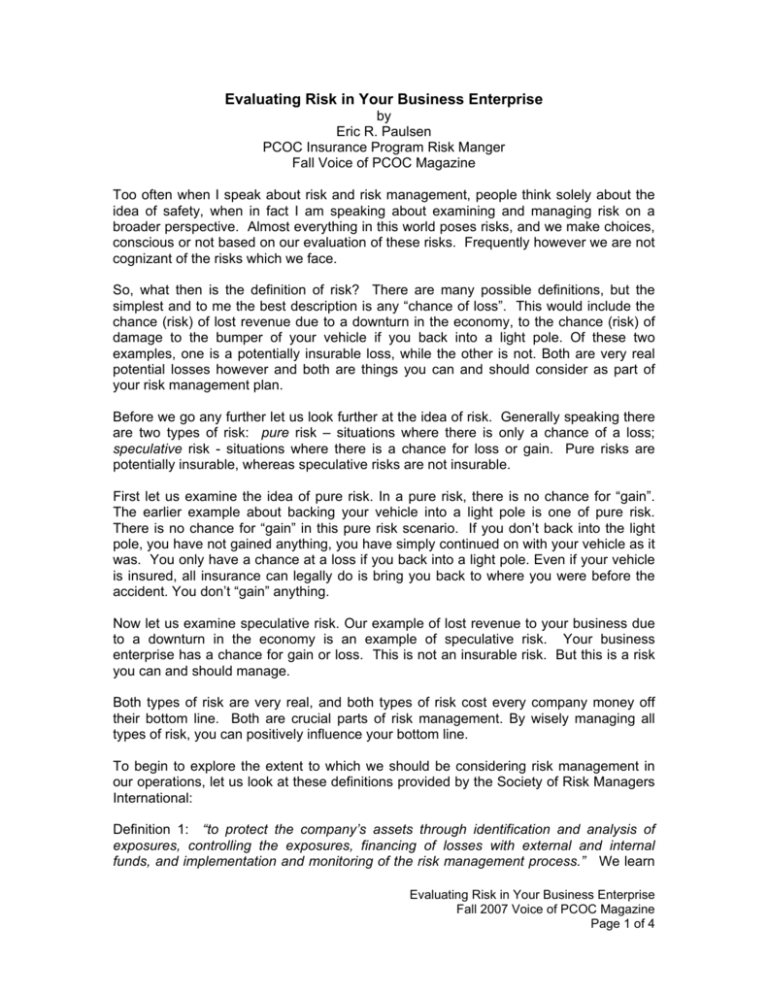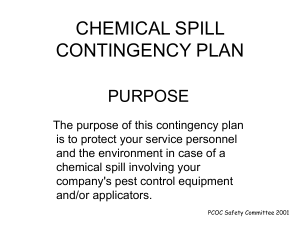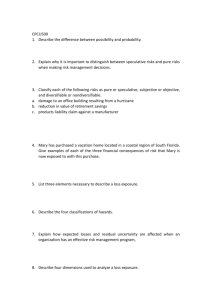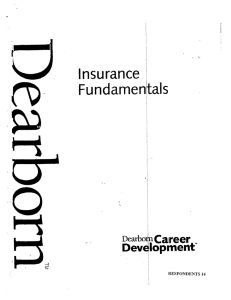Evaluating Risk in Your Business Enterprise
advertisement

Evaluating Risk in Your Business Enterprise by Eric R. Paulsen PCOC Insurance Program Risk Manger Fall Voice of PCOC Magazine Too often when I speak about risk and risk management, people think solely about the idea of safety, when in fact I am speaking about examining and managing risk on a broader perspective. Almost everything in this world poses risks, and we make choices, conscious or not based on our evaluation of these risks. Frequently however we are not cognizant of the risks which we face. So, what then is the definition of risk? There are many possible definitions, but the simplest and to me the best description is any “chance of loss”. This would include the chance (risk) of lost revenue due to a downturn in the economy, to the chance (risk) of damage to the bumper of your vehicle if you back into a light pole. Of these two examples, one is a potentially insurable loss, while the other is not. Both are very real potential losses however and both are things you can and should consider as part of your risk management plan. Before we go any further let us look further at the idea of risk. Generally speaking there are two types of risk: pure risk – situations where there is only a chance of a loss; speculative risk - situations where there is a chance for loss or gain. Pure risks are potentially insurable, whereas speculative risks are not insurable. First let us examine the idea of pure risk. In a pure risk, there is no chance for “gain”. The earlier example about backing your vehicle into a light pole is one of pure risk. There is no chance for “gain” in this pure risk scenario. If you don’t back into the light pole, you have not gained anything, you have simply continued on with your vehicle as it was. You only have a chance at a loss if you back into a light pole. Even if your vehicle is insured, all insurance can legally do is bring you back to where you were before the accident. You don’t “gain” anything. Now let us examine speculative risk. Our example of lost revenue to your business due to a downturn in the economy is an example of speculative risk. Your business enterprise has a chance for gain or loss. This is not an insurable risk. But this is a risk you can and should manage. Both types of risk are very real, and both types of risk cost every company money off their bottom line. Both are crucial parts of risk management. By wisely managing all types of risk, you can positively influence your bottom line. To begin to explore the extent to which we should be considering risk management in our operations, let us look at these definitions provided by the Society of Risk Managers International: Definition 1: “to protect the company’s assets through identification and analysis of exposures, controlling the exposures, financing of losses with external and internal funds, and implementation and monitoring of the risk management process.” We learn Evaluating Risk in Your Business Enterprise Fall 2007 Voice of PCOC Magazine Page 1 of 4 here the key goal is to protect the company’s assets through a comprehensive risk management process. Definition 2: “identifying, analyzing, controlling, financing, and administering operational risks - as well as political risks, catastrophic loss exposures, third-party exposures, fiduciary exposures, employee injury exposures, juridical risks, legal risks, and more whether insurable or not.” In this more detailed description it is clarified that we need to consider all risks whether insurable or not, and we get a glimpse at some of the many external risk factors which can potentially affect our businesses. As we begin to think about risk management in this broader perspective it helps to put some parameters on these risks. In risk management theory, there are six classes of risk that businesses need to anticipate to the best extent possible and build into their overall business strategy: economic risk, legal risk, political risk, social risk, physical risk, and juridical risk. Let us briefly look at each of these classes of risk. Economic Risk: This is the risk your firm has of encountering losses as it relates to the economics of your internal operations, the external marketplace, financial markets, and entrepreneurial risks. One example of an area where we have been advising members regarding economic risks are our recommendations to Branch 3 companies to pursue expanding a larger percentage of their business to direct consumer driven work as opposed to simply relying upon the real estate industry. Legal Risk: This is the risk your firm has of encountering losses as it relates to regulatory or statutory liability. Much of the regulatory compliance advice relates to helping ensure that your firm operates legally to avoid not only fines, but to avoid loss of business due to a record of violations or a potential shut down of your firm for a period of time. Political Risk: This is the risk your firm has of encountering losses as it relates to legal changes, or governmental re-interpretations. Recently some several district attorneys have reinterpreted Department of Transportation (DOT) and pesticide storage rules, claiming that local cities have jurisdiction over the fumigants stored on fume trucks, whereas the historical interpretation has been that these fumigants stored on vehicles fell under the jurisdiction of DOT rules. This is a perfect example of political risk, which cost one-company significant amounts of money to successfully fight. Another example of political risk would be the changes in the Fish & Game rules and interpretations, which adversely affected Branch 2 licensee’s ability to trap many animal species. These are but two examples, and we are certainly at risk of political changes effecting change, which would cause us to lose our ability of our using fumigants, pyrethroids and many other products, all of which could negatively affect our bottom line. Social Risk: This is the risk your firm has of encountering losses as it relates to the public’s perception of your firm, or of structural pest control as an industry. The socalled environmental movement and their public relations efforts are effectively stigmatizing traditional pest control in lieu of non-traditional pest control in some parts of society. This shift in social perspective has helped in the growth of alternative controls for drywood termites, and is likely to be a key driving force putting many of our current pest control business models and practices at risk. This is an example of social risk. As a business by closely watching future social trends, you can diversify your services to Evaluating Risk in Your Business Enterprise Fall 2007 Voice of PCOC Magazine Page 2 of 4 limit the impact, and anticipate future changes to prepare to offer what the public will want in the future. Physical Risk: This is the area of risk that we are most familiar with, which is the risk of encountering losses as it relates to a physical damage or loss to people, property, or even information. Speaking of information, have I reminded you to back up your data lately? No? Please back up your data, and store it in a secure location!` Most of our “traditional” safety programs and technical training programs are directed at managing and minimizing physical risks. Juridical Risk: This is the risk of encountering losses due to the decision of a judge or jury. While we may “know” we are right, juries and judges are notorious for making choices, which hurt businesses. This can be found both in the obvious situation of your firm being sued, and the case being adjudicated by the courts, to larger decisions which a court could make which adversely affect your business, such as a environmental lawsuit against EPA relating to the use of pesticides adversely affecting endangered species could potentially have a significant financial impact on your business. Every action and inaction of our firms, from the nature of your corporate filings, to how you hire and screen your employees and clients, are all part of how your manage your business and how you manage the risk you firm is exposed to. By properly managing risks you are properly managing your company. Risk costs money. You are in business to make money. Too often people don’t recognize the costs of risk, and miss huge opportunities to manage your company more effectively and efficiently. There are very real direct and indirect costs of risk. Wise companies track these costs very closely and where applicable allocate those costs to help in their management. Direct costs of risk: 1. Insurance premiums. 2. Retained losses. These include deductibles, self-insured retentions, and other retained losses. Most companies have more retained losses than they really think about. If it is not directly insured, then you are retaining the loss. This would include insurable risks for which you don’t have insurance, as well as uninsurable risks. Another example are costs of the loss of business due to a business shut down or slow down due to a regulatory action, lawsuit, or any of the other many areas our business are at risk every day. 3. Risk management costs, which include training of employees, and all overhead associated with managing the risk exposure to your firm. 4. Outside services, such as legal fees, broker fees, service fees, third party administrators if you have a self-insured program, and risk management consulting fees. Indirect costs of risk: 1. Costs of training new employees 2. Loss of productivity after an accident 3. The labor and incidental costs of dealing with claims, following up with injured employees, lawyers, body shops, and the like. Evaluating Risk in Your Business Enterprise Fall 2007 Voice of PCOC Magazine Page 3 of 4 Do we see a trend here? Risk management is about managing your company. To a large extent it relates to finances, or more specifically about protecting assets. When reading this description it sounds like this should be the job of the Chief Executive Officer (CEO) or Chief Financial Officer (CFO) does it not? Indeed in the corporate world at large the most common person or department who is responsible for risk management is the CFO. More and more companies such as Microsoft are moving toward the Chief Risk Officer (CRO) model, where the CFO and CRO are peers in the corporate hierarchy. In smaller companies such as we find in the structural pest control industry, it is clear that the person who is responsible for managing the risks threatening the financial well being of these companies are the owners and top level managers. For the average member of the Pest Control Operators of California, the owner of the company is the chief executive officer, the chief finance officer, the risk manager, human resources manager, payroll manager, supervisor, all rolled up in one, not to mention being an active termite inspector and general pest tech to boot! As an owner of a company we integrate our thought process in a seamless process, evaluating the strategic, financial, and supervisorial ramifications of a situation simultaneously and then implementing a management decision incorporating these and many other realms of management thought. What is frequently missing in this process is the evaluation and implementation of the risk factors relating to the issue. By training ourselves to consciously investigate, evaluate and manage risks in our businesses we will eventually begin to integrate risk management into our every day thought process of how we manage our businesses. The PCOC Insurance Program is in the business of helping you manage your companies and specifically to aid in your managing your risks. Insurance is a useful and important tool used in managing risk, but it is far from the only tool. Unlike our competition, since our inception in the 1980s the professionals at the PCOC Insurance Program have been here to assist you in managing both your insurable and uninsurable risks, to ensure your long-term success. Evaluating Risk in Your Business Enterprise Fall 2007 Voice of PCOC Magazine Page 4 of 4








